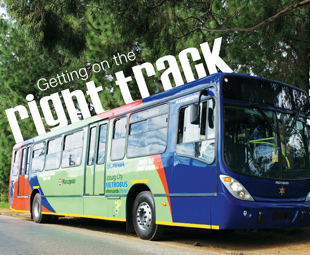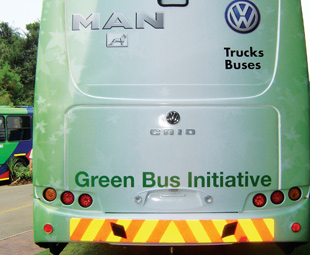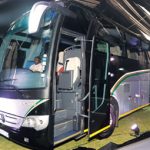Getting on the right track

The annual South African Bus Operators Association (SABOA) conference tends to be a good marker of what’s happening in the world of local public transport. When NADINE VON MOLTKE attended the event, she found positive and negative developments in equal measure.
One of the more troubling aspects of this year’s SABOA conference was a lack of organisation and stability amongst some of the country’s key public transport players and departments.
Three of the main speakers were “acting” holders of their positions: the acting MMC for transport and roads for the city of Tshwane; the acting director-general of the Department of Transport (DoT); and the acting chief director: economic regulation, DoT were all guest speakers. The acting MMC for transport and roads for the city of Tshwane, Mrs Moselelane, was unable to attend the event, so a member of the Tshwane city council read her speech in her stead.
This litany of “acting” dignitaries begs one very important question: how can any stability be maintained or real changes implemented in a sector with no clear leadership?
According to Mrs Moselelane – whose speech was delivered in abstentia – Tshwane is currently facing a number of challenges. These include overcrowded public transport facilities, fragmented planning, a deteriorated infrastructure, and a lack of integration amongst the various modes of transport.
“The economic and social impacts of these issues are widespread,” noted the councillor who delivered the speech on her behalf, adding that an integrated transport plan has been developed to address the situation. “The city of Tshwane believes that an efficient public transport system is more important to sustainable development than private modes of transport. We want to develop a customer-focused service that is safe, reliable, affordable and convenient, and which encourages all operators to follow these standards,” the speech concluded.
 A laudable goal certainly, and one that cities around the country are aiming to achieve. Once again, however, without strong leadership and developed departments dealing with these issues, what can really be accomplished?
A laudable goal certainly, and one that cities around the country are aiming to achieve. Once again, however, without strong leadership and developed departments dealing with these issues, what can really be accomplished?
Municipal budgets are stretched to breaking point; disagreement on how integrated public transport systems can be achieved, and who will control the bigger slice of the pie, continue to deadlock developments; and the leadership of many of these projects is shaky at best.
By contrast, the activities of the South African National Roads Agency Ltd (SANRAL) have shown marked success over the past year. The South African government, represented by the Minister of Transport, is the sole shareholder and owner of SANRAL, whose mandate is to finance, improve, manage and maintain the national road network ( South Africa’s “economic arteries”). This mandate is achieved through allocations made by the National Treasury for non-toll roads, as well as by borrowing against this capital and from money markets to fund toll roads, or through the concessioning of roads to private sector consortia.
According to Nazir Alli, SANRAL’s chief executive officer (CEO), the national road network – although currently in the midst of a massive upgrade – is not suffering from a backlog. “We attend to any problems expeditiously through contractors across the network who are contractually bound to address any issues within 48 hours,” he said.
Unfortunately, regional road networks are a different matter. During the question and answers session, a number of delegates implored Alli to address the issues of potholes plaguing the entire South African network; to which Alli repeatedly replied that SANRAL was responsible for the national road network alone, and that this network at least was well maintained.
The system does not work so well that it will not be changing in the near future, however, which was the key concern of Alli’s address: the introduction of the national toll strategy, set to go live in April 2011.
“Only 3 200 km of the 16 000 km controlled by SANRAL are tolled,” explained Alli. “Where does the money for the rest of the network come from? From treasury, and it’s not enough.
“The road-user facilities on our roads are appalling and it is individuals and companies who ultimately pay the price of this through high accident statistics, lowered productivity as a result of heightened travel time, and even the difficulties emergency vehicles have reacting to problems.
“Because, as a nation, we don’t behave responsibly on our roads, the money SANRAL receives from the fiscus cannot cover costs. Even the fuel levy is inadequate to cover the social costs of pollution and delays from too many road users.”
SANRAL’s solution is to implement a toll system that will not only contribute towards these costs, but discourage members of the general public from using roads unnecessarily when public transport or car pools are alternative options.
Public transport operators will naturally qualify for a discount on these roads, and a question from the floor raised the issue of discounts based on carbon-credits. In other words, will a “greener” bus (or truck for that matter), qualify for discounted toll rates based on its limited impact on the environment? We will need to wait and see.
Green solutions
One of the most noteworthy bus and exhibition displays at SABOA was the “green bus pilot initiative” which was conceptualised jointly by Metrobus and two manufacturers, Scania and MAN-owned VW Trucks Buses. “Government has been slow in coming to the party,” explains Dave Gregory, general manager, Technical Metrobus. “Although full support is given by the City of Johannesburg’s Transport Department and Metrobus’ managing director, Herman Van Laar – with assistance from SANERI (South African National Energy Research Institute) – in projects of this nature, there are no initiatives currently in place or incentives for operators to run greener operations. The industry requires assistance in the form of reduced import duties and license fees, for example.”
According to Gregory, two million CNG (compressed natural gas) buses are currently operating in Pakistan and 1.8 million in Iran. “South Africa should be at the forefront of operations of this nature,” he adds. “We have the expertise, the land space and a good supply of natural gas.”
 Taking matters into their own hands, Gregory and the Metrobus team have now recruited Scania and MAN to help them run a pilot project proving the viability of green buses in South Africa.
Taking matters into their own hands, Gregory and the Metrobus team have now recruited Scania and MAN to help them run a pilot project proving the viability of green buses in South Africa.
The two buses in question – a Scania ethanol bus and a CNG/diesel dual-purpose Volksbus – remain the property of their manufacturers, while Metrobus has undertaken to foot the bill for the buses’ running costs over the next six months.
“We bought the bus in order to be able to pilot this project in South Africa,” explains Winston Muir, bus sales exco, Scania SA. Of course, the bus has a Scania chassis, fitted in this case with a Marcopolo body. Scania South Africa, with some financial support from Scania Sweden, purchased the bus itself and will continue to run similar projects around the country once the Metrobus pilot project is complete.
There are currently 450 Scania ethanol buses operating in the Swedish capital of Stockholm, so the manufacturer is no stranger to this technology.
“We have the partners, and the technology is available; all we need is governmental buy-in,” repeats Gregory. The City of Johannesburg has already acknowledged the poor state of Jo’burg’s air quality, which is one of the reasons why the bus rapid transit (BRT) system, Rea Vaya, is operated with Euro 4 standard buses. However, this is only one step in the process.
“Buying an ethanol or CNG bus is no more costly than buying a normal bus,” explains Gregory. “However, they are more expensive to operate. That’s why, without incentives from Government, there is no real market in South Africa for this technology. The manufacturers have these buses available; they just aren’t bringing them to South Africa because there is no demand for them.”
Gregory hopes to change this. The two buses will operate from the Metrobus Ferndale depot in Randburg, where a portable natural gas line and a portable ethanol tank supplied by Scania will refuel them. The ethanol will be supplied by a local producer, the Silversands community partnership programme, based in the Lichtenburg farming district.
This partnership not only supplies high-quality fuel (which must meet Scania’s standard of 92.7% strength) but provides an ideal opportunity for local, struggling farmers to derive additional value from their crops in the face of dwindling grain market prices. Silversands’ ethanol is based on the hardy sugerbeet.
“The value of these projects is so far reaching,” says Gregory. “For every litre of ethanol we use, that’s one litre of foreign oil we don’t need to import. It also creates sustainable employment for local farmers and a whole new local industry from which our rural areas can benefit, over and above the environmental advantages of operating green buses.”
South Africa also has abundant access to natural gas: most notably through its neighbour, Mozambique. “There are a number of cities in India and Australia whose public transport systems are based on CNG buses,” Gregory adds. “They have access to the resource and it’s better for the environment. Why haven’t we gone the same way?” Metrobus’ current fleet of 500 buses burns through 650 000 litres of fuel each month.
“Transport accounts for 11% of our pollution overall, but this is heightened in cities such as Johannesburg,” explains Gregory. “It’s inevitable that we will eventually need to change our fleets to greener technology. Why not get ahead of the game, iron out all the kinks and start running truly efficient operations?”
However, without incentives from local city authorities, a reduction in import duties for manufacturers, tax reductions for operators and incentives linked to the earning of carbon credits, operators are unlikely to start making the move themselves.
Metrobus, Scania and MAN have started the ball rolling by embarking on a project aimed at proving that alternative-fuel buses can operate under local conditions. The “green initiative” branded buses should be promoting the project on our roads by the end of March.
Both buses were prominently displayed at the conference, giving the entire event a green theme. “I had many conference attendees telling me the initiative won’t work,” says Gregory. “It’s an unbelievably short-sighted view. Right now we look like pioneers, but what we’re really doing is just getting ahead of the game.”
Published by
Focus on Transport
focusmagsa




